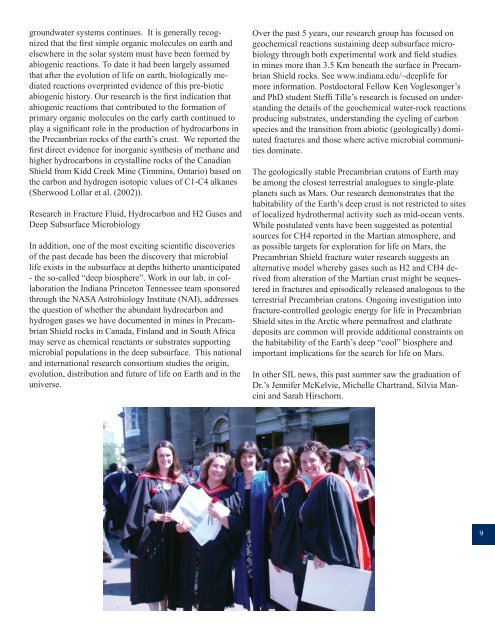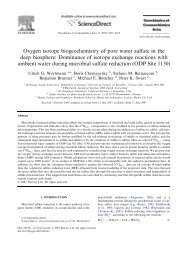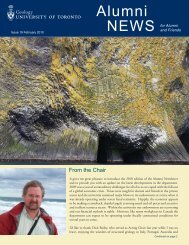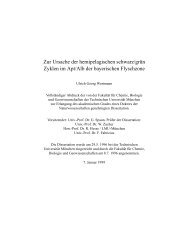13000_final3.ps, page 1-20 @ Normalize ( 13000_final.indd )
13000_final3.ps, page 1-20 @ Normalize ( 13000_final.indd )
13000_final3.ps, page 1-20 @ Normalize ( 13000_final.indd )
You also want an ePaper? Increase the reach of your titles
YUMPU automatically turns print PDFs into web optimized ePapers that Google loves.
groundwater systems continues. It is generally recognizedthat the first simple organic molecules on earth andelsewhere in the solar system must have been formed byabiogenic reactions. To date it had been largely assumedthat after the evolution of life on earth, biologically mediatedreactions overprinted evidence of this pre-bioticabiogenic history. Our research is the first indication thatabiogenic reactions that contributed to the formation ofprimary organic molecules on the early earth continued toplay a significant role in the production of hydrocarbons inthe Precambrian rocks of the earth’s crust. We reported thefirst direct evidence for inorganic synthesis of methane andhigher hydrocarbons in crystalline rocks of the CanadianShield from Kidd Creek Mine (Timmins, Ontario) based onthe carbon and hydrogen isotopic values of C1-C4 alkanes(Sherwood Lollar et al. (<strong>20</strong>02)).Research in Fracture Fluid, Hydrocarbon and H2 Gases andDeep Subsurface MicrobiologyIn addition, one of the most exciting scientific discoveriesof the past decade has been the discovery that microbiallife exists in the subsurface at depths hitherto unanticipated- the so-called “deep biosphere”. Work in our lab, in collaborationthe Indiana Princeton Tennessee team sponsoredthrough the NASA Astrobiology Institute (NAI), addressesthe question of whether the abundant hydrocarbon andhydrogen gases we have documented in mines in PrecambrianShield rocks in Canada, Finland and in South Africamay serve as chemical reactants or substrates supportingmicrobial populations in the deep subsurface. This nationaland international research consortium studies the origin,evolution, distribution and future of life on Earth and in theuniverse.Over the past 5 years, our research group has focused ongeochemical reactions sustaining deep subsurface microbiologythrough both experimental work and field studiesin mines more than 3.5 Km beneath the surface in PrecambrianShield rocks. See www.indiana.edu/~deeplife formore information. Postdoctoral Fellow Ken Voglesonger’sand PhD student Steffi Tille’s research is focused on understandingthe details of the geochemical water-rock reactionsproducing substrates, understanding the cycling of carbonspecies and the transition from abiotic (geologically) dominatedfractures and those where active microbial communitiesdominate.The geologically stable Precambrian cratons of Earth maybe among the closest terrestrial analogues to single-plateplanets such as Mars. Our research demonstrates that thehabitability of the Earth’s deep crust is not restricted to sitesof localized hydrothermal activity such as mid-ocean vents.While postulated vents have been suggested as potentialsources for CH4 reported in the Martian atmosphere, andas possible targets for exploration for life on Mars, thePrecambrian Shield fracture water research suggests analternative model whereby gases such as H2 and CH4 derivedfrom alteration of the Martian crust might be sequesteredin fractures and episodically released analogous to theterrestrial Precambrian cratons. Ongoing investigation intofracture-controlled geologic energy for life in PrecambrianShield sites in the Arctic where permafrost and clathratedeposits are common will provide additional constraints onthe habitability of the Earth’s deep “cool” biosphere andimportant implications for the search for life on Mars.In other SIL news, this past summer saw the graduation ofDr.’s Jennifer McKelvie, Michelle Chartrand, Silvia Manciniand Sarah Hirschorn.9








